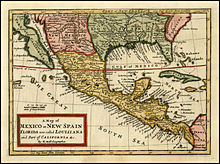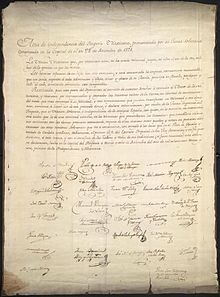Name of Mexico

Several
As far back as 1590, the
In 1821, the continental part of New Spain seceded from Spain during the
After the Empire fell and the Republic was established in 1824, a
Complications arose with the capital's former colloquial and semi-official name "Ciudad de Mexico, Distrito Federal (Mexico, D.F.)", which appears on postal addresses and is frequently cited in the media, thus creating a duplication whereas the shortened name was "Mexico, D.F., Mexico". Legally, the name was Distrito Federal (Federal District or District of the Federation). This ended with the change in status of Mexico City in 2016. Today it is officially called "Ciudad de México, México" abbreviated CDMX, Mexico.
The official name of the country is the "United Mexican States" (
Names of the country

During the 1810s, different insurgent groups advocated and fought for the independence of the vice-royalty of New Spain. This vast territory was composed of different

In September 1821, the independence of Mexico was finally recognized by Spain, achieved through an alliance of royalist and revolutionary forces. The former tried to preserve the status quo of the vice-royalty, menaced by the liberal reforms taking place in Spain, through the establishment of an autonomous
Mexican States is the normative English translation.
On 22 November 2012, incumbent President
Etymology
According to one legend,
Another hypothesis
Still another hypothesis[15] offers that it is derived from Mectli, the goddess of maguey.
These last two suggestions are deprecated by linguist Frances Karttunen,
Mexico and Mexica
The name Mexico has been commonly described to be a derivative from Mexica, the autonym of the Aztec people,[17] but said affirmation is controversial as there are many competing etymologies for both terms[18] and given the fact that in many old sources, 'Mexica' simply appears as the way to call the inhabitants of the island of Mexico (where Tenochtitlan and Tlatelolco were located) in their native Nahuatl;[19] implying that instead of Mexica being the source of the name 'Mexico', the opposite would be true.[20]
Phonetic evolution
The Nahuatl word Mēxihco (Nahuatl pronunciation: [meːˈʃiʔko] ⓘ) was transliterated as "México" using Medieval Spanish orthography, in which the x represented the voiceless postalveolar fricative ([ʃ], the equivalent of English sh in "shop"), making "México" pronounced as [ˈmeʃiko]. At the time, Spanish j represented the voiced postalveolar fricative ([ʒ], like the English s in "vision", or French j today). However, by the end of the fifteenth century j had evolved into a voiceless palato-alveolar sibilant as well, and thus both x and j represented the same sound ([ʃ]). During the sixteenth century this sound evolved into a voiceless velar fricative ([x], like the ch in Scottish "loch"), and México began to be pronounced [ˈmexiko].[21]
Nevertheless, there was ambivalence in the application of this rule in Mexican toponyms: México was used alongside Méjico,
In present-day Spanish, México is pronounced [ˈmexiko] or [ˈmehiko], the latter pronunciation used mostly in dialects of southern Mexico, the Caribbean, much of Central America, some places in South America, and the Canary Islands and western Andalusia in Spain where [x] has become a voiceless glottal fricative ([h]),[22][23] while [ˈmeçiko] in Chile and Peruvian coast where voiceless palatal fricative [ç] is an allophone of [x] before palatal vowels [i], [e].
Normative spelling in Spanish
México is the predominant
See also
- Mexican state name etymologies
References
- ISBN 96816029519789681602956
- ^ Rafael Romo (26 November 2012). "After nearly 200 years, Mexico may make the name official". CNN. Retrieved 4 January 2014.
- ^ Historia de la Ciudad de México Archived 2007-02-03 at the Wayback Machine Gobierno del Distrito Federal
- ^ Decreto Constitucional para la Libertad de la América Mexicana Archived 2013-05-20 at the Wayback Machine
- ^ ¿Puede ser libre la Nueva España?
- ^ "Universidad Anáhuac". Archived from the original on 2009-01-22. Retrieved 2007-04-15.
- ^ A Nahuatl Interpretation of the Conquest Archived 2012-03-16 at the Wayback Machine
- ^ Constitución federal de los Estados Unidos mexicanos (1824)
- ^ Federal Constitution of the United Mexican States (1824) Archived 2016-04-16 at the Wayback Machine (original scans with Spanish and English text): Texas Constitutions, University of Texas at Austin; also see Printing History Archived 2013-08-07 at the Wayback Machine
- ^ Constitución Federal de los Estados Unidos Mexicanos (1857)
- ^ Constitución Política de los Estados Unidos Mexicanos (1917)
- ^ 1917 Constitution of Mexico, Official Site of the Mexican Government (English)
- ^ Mexico's President Calderon seeks to change country's name
- ^ Aguilar-Moreno, M. Handbook to Life in the Aztec World, p. 19. Facts of Life, Inc. (New York), 2006.
- ^ a b Gobierno del Estado de México. Nombre del Estado de México Archived 2007-04-27 at the Wayback Machine. (in Spanish)
- ^ Karttunen, Frances. An Analytical Dictionary of Nahuatl, p. 145. University of Oklahoma Press (Norman), 1992.
- ^ An Analytical Dictionary of Nahuatl - Frances Karttunen p145
- ISBN 96816029519789681602956
- ^ "Mexica - Gran Diccionario Náhuatl".
- ^ "Mexicatl - Gran Diccionario Náhuatl".
- ^ Evolution of the pronunciation of x Real Academia Española
- ^ PronounceNames.com· (23 September 2012). "How to Pronounce Mexico - PronounceNames.com" (Video upload). YouTube. Google Inc. Archived from the original on 2021-12-14. Retrieved 12 December 2013.
- ^ Canfield, D[elos] Lincoln (1981), Spanish Pronunciation in the Americas
- ^ Real Academia Española Diccionario Panhispánico de Dudas
- ^ "Mexico" Merriam-Webster's Online Dictionary
